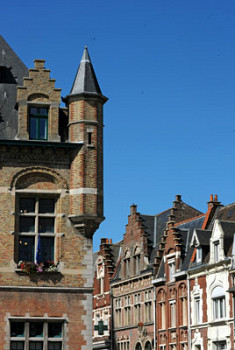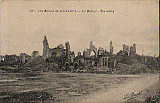Contents
Bailleul was invaded for the first time by the Germans in October 1914. One week later the town was retaken by the British Army and turned into a rear base for its many soldiers engaged in the fighting on the Ypres Salient. In addition to the troops and military general staff, the town also accommodated the army medical and surgical services. In 1917 the German Army decided to attempt a pincer movement to isolate Ypres and, to succeed, this required heavy shelling of Allied rear bases, and one of those was Bailleul which saw its train station and main streets damaged. In 1918 the great German Spring Offensive brought about the almost total destruction of the town in April, the last few standing buildings being demolished during its subsequent liberation. By the close of the war 98% of the town had been destroyed.
The architect Louis-Marie Cordonnier was selected to coordinate the reconstruction effort in the Lys Valley. For Bailleul, Cordonnier surrounded himself with a team of regionalist architects such as Louis Roussel, Jacques Barbotin, and brothers René and Maurice Dupire. The guiding principle of the reconstruction here was not to rebuild what had existed before because, unlike Arras, pre-war Bailleul had no remarkable architecture to speak of. Indeed, the buildings in the town were either rendered or painted to imitate stone and had nothing typically Flemish about them when viewed through the eyes of the regionalist architects of the early 20th century. So, in this case, the reconstruction of the town was more the invention of a Flemish regionalism based on the ideas held by the architects who redesigned it rather than any historical research. It was theatrical, a Utopian decor, almost cinematic, designed to promote a sense of regionhood that would be the foundation of the French nation's rebirth after the war.
Nevertheless, like elsewhere, Louis-Marie Cordonnier did not impose his style on the town but allowed the new Bailleul to appropriate its own architectural diversity. Cornudet's law of 1919 required all towns of over 10,000 inhabitants to draw up plans for future development, improvement or extension. Approved in 1920, Louis-Marie Cordonnier's plan retained the town's old layout whilst improving access and public health. The streets were to be enlarged and an urban network created. In 1921 Mayor Natalis Dumez, concerned by delays in the payment of State aid and wanting to move the reconstruction forward, decided to reduce the scale of the undertaking to what was essentially the pre-war layout of the town.
Works began in the 1920s and continued through to the early 1930s, the town hall being completed in 1932. Louis-Marie Cordonnier rebuilt the town hall in a similar size to the previous one, but made it more imposing, and he retained the 13th century Gothic chamber. He gave it a sixty-two metre high belfry topped with an onion- shaped dome. The administrative departments were installed on the ground floor and the prestigious rooms on the first floor.
The reconstruction was an opportunity to make general improvements to the town's infrastructure by both rebuilding existing institutions, such as the museum and the art school, and adding new services. Schools were rebuilt in compliance with modern requirements such as installing large windows to provide as much natural light as possible. The nursery school was installed in a separate building in the school for girls. The school for boys was built next to a bathhouse, the latter open not only to schoolchildren but also to the general public. The old hospice was transformed into a modern health centre comprising a hospital, a hospice proper, and a maternity ward.
Houses were rebuilt in a regionalist style. The involvement of several architects meant the designs were not monotonous or stereotyped. In the aftermath of the war part of the population was housed in temporary shelters. During the 1920s up to 1934 a Bailleul housing association (Société anonyme des Habitations à Bon Marché – HBM) built 300 houses comprising two rooms on the ground floor, two bedrooms on the first floor, an attic and a garden of 200 to 300 square metres.
The district psychiatric hospital for women was destroyed in 1918. The new establishment took the form of several detached cottages dotted around a park, the idea being that a pleasant setting would reduce the feeling of imprisonment and improve the patients' chances of recovery.
With its reconstruction complete, Bailleul would enjoy the infrastructure of a town revitalized, in an architectural setting firmly rooted in its past.
Claude FOURET,
Professor of History





